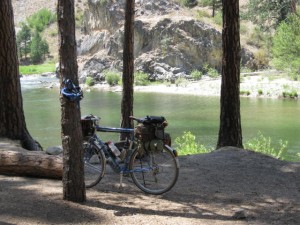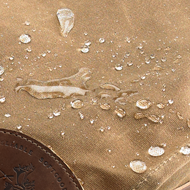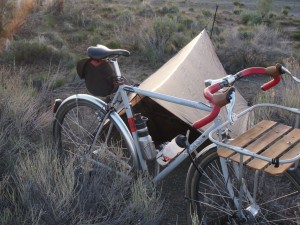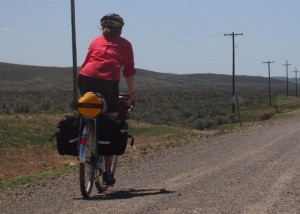This post is a placeholder for comments on the specific section of the Idaho Hot Springs Mountain Bike Route maps published by Adventure Cycling Association. People who have ridden this section of the route are encouraged to report on current conditions by using the Comments. The reliability and timeliness of the reports depend solely on the contributors. Bike Touring News takes no responsibility for any outdated or inaccurate information here. For an index of all the sections of the route please see this page.
Author: Bike Hermit®
This post is a placeholder for comments on the specific section of the Idaho Hot Springs Mountain Bike Route maps published by Adventure Cycling Association. People who have ridden this section of the route are encouraged to report on current conditions by using the Comments. The reliability and timeliness of the reports depend solely on the contributors. Bike Touring News takes no responsibility for any outdated or inaccurate information here. For an index of all the sections of the route please see this page.
This post is a placeholder for comments on the specific section of the Idaho Hot Springs Mountain Bike Route maps published by Adventure Cycling Association. People who have ridden this section of the route are encouraged to report on current conditions by using the Comments. The reliability and timeliness of the reports depend solely on the contributors. Bike Touring News takes no responsibility for any outdated or inaccurate information here. For an index of all the sections of the route please see this page.

Yes, I coined a new term; “A24O”- for “about 24 hours over-nighter”. The “S24O” or “sub 24 hour over-nighter” seems too extreme. Too much pressure to return home in less than 24 hours, especially from Boise where the distances to decent camping spots are greater than in some other shires.
We rolled out the front door at about 10 AM Saturday morning and by shear luck, even though it would be almost 100 degrees by the afternoon, there was a nice cloud cover most of the morning which even sprinkled a little rain. We followed the Boise Greenbelt out past Harris Ranch to Lucky Peak Dam. There is a four mile climb to the Hilltop store, which is open again (hope they can keep it going) and actually has a nice selection of beer, so there was no need to have lugged our adult beverages up that hill! A fast descent and a sharp right past the high bridge brings us to Spring Shores Marina. It’s another 5 1/2 miles of pavement before the road turns to dirt/gravel/sand which is severely washboarded in places by the almost steady (on the weekend anyway) traffic of recreationalites with their recreational vehicles.
Arrowrock Reservoir is bigger than I realized. We followed the road along the upper shoreline for about 14 miles to the upper end of the reservoir where the Middle Fork of the Boise River flows freely again. This is where the climate becomes more alpine too. Pine trees begin to replace the clumps of Black Locust growing at the lower, dryer elevations. Indeed, it seems a bona fide forest at Willow Creek Campground.



I’m still undecided about the best bike for this kind of trip. Most of the miles are on pavement but the unpaved sections can be sort of jarring and tiring. I rode my touring bike with 700x35c tires while Sky King rode her Bleriot with 650bx42mm Grand Bois Hetre tires, and neither one of us had any significant problems. The smooth tread tires were nice on the paved sections. Bikes with even more voluminous tires would flatten out the bumps a little on the unpaved sections and provide better traction I think. So there are compromises on a trip like this. We will be covering the same ground on the last day of the upcoming Ketchum to Boise ride and we both want fatter tires. Sky King will be buoyed by 26″x2.4″ Schwalbe tires on the Disc Trucker. The Surly Big Dummy has unexpectedly risen to the top of my own short list of off road touring bikes. The frame is designed to fit tires up to 2.5″ wide, even if tire selection in that size is a little bit limited. And the long wheel base distributes the weight of the rider and the load more evenly between the two wheels resulting in better traction and more stable handling….theoretically. The longer wheelbase undoubtedly would smooth out the chatter bumps on these gravel roads too. In more remote areas drinking water can be the major challenge to doing off road back-country rides fully self-supported. With its 200 pound load capacity, not including the rider, and its capacious bags the Big Dummy unlocks that conundrum. The only downside I can see is if the need arose for some bushwhacking or log hopping to get to that perfect campsite, but that is not a deal breaker.
Oops….. this post has encountered a bit of metaphorical sand and could easily slide over the bank into the weeds of B.R.O.C.D. (bike related obsessive compulsive disorder). Careful, just a little body english, don’t over correct…..right, back on form. So figure on a solid 5 hours to do this 40+ mile ride one way on a loaded bike. There is drinking water at Hilltop, at Spring Shores Marina and at the Willow Creek Campground. The campground is a no fee forest service facility with picnic tables and plenty of trees and good access to the river. The area is very popular on summer weekends and the auto traffic is heavy, especially on Sunday afternoon.
Old Man Mountain
The Bike Touring News Store has Old Man Mountain racks! Designed and made in Santa Barbara, CA. Old Man Mountain has a rack for almost any bike including full suspension mountain bikes and fat bikes.
Here’s an Adventure Cyclist Story from 2004. It describes the genesis of the company, the owner’s background and some of the philosophy behind the designs.
Please check the offerings in our store and feel free to contact us if you have questions or need a rack you don’t see.
A Tough Decision
A few years ago I bought a Rivendell Roadeo frame set. I always wanted a modern version of the Bridgestone RB-1 but Grant told me that would never happen. The RB-1 was a great bike and they sell for more nowadays than they did new, but Grant made compromises to satisfy sales people and company suits and bike dealers when he designed that bike, compromises he is no longer willing or required to make. So the Roadeo is probably as close as it gets, maybe- probably, even better.
But I also have a Rivendell A. Homer Hilsen and the two bikes overlap in design philosophy. So, after much deliberation, I have decided to sell the Roadeo frame set. No parts have ever been bolted on and the frame set is pristine. I even have the original shipping box.
- 59 cm
- Threadless and un-cut steer tube
- Frame and fork only…no headset or bottom bracket
I am asking $2000.00. New Roadeos from Rivendell are now $2200 and there is a 3 month (minimum) wait. If you are truly interested in buying this, please contact me (bikehermit at biketouringnews dot com)
Here are some pics:
The new shipment of Frost River bike bags arrived at the Bike Touring News Store last week. Frost River may be better known for their canoe packs than for bicycle touring bags but both should be held to the same standard –
“Canoe packs are built for a very specific task (hauling the stuff that will sustain you) in a very specific environment (the Northern Wilderness). In this setting, things like a seam ripping or a sidewall tearing or a strap breaking—little failures that would be an annoyance in everyday life—come with huge consequences.”
-And so it goes for bike touring.
Frost River makes their bags in Duluth Minnesota from materials sourced in the USA.

The waxed cotton canvas comes from Fairfield Textiles and is called Martexin Original Wax. The fabric is claimed to have a lifelong resistance to inclement weather as well as being naturally breathable. The hand is not course or stiff even though the canvas is stout. It is evident that the material is impregnated with wax rather than simply coated.

The leather in the straps and reinforcements comes from S.B. Foot Tanning Co. in Red Wing MN. Yes, that Red Wing. I currently have two pairs of Red Wing shoes and it’s sort of neat to know the leather in my bike bag comes from the same source!

All the buckles, snaps, slides and d-rings are solid brass, not simply plated. And they are big. They might almost appear clunky to some but when fumbling with cold fingers and/or in the dark I think I will appreciate the large size.
The Gunflint Trail is the larger of the two traditional style “transverse” saddlebags from Frost River and it is big. The stated capacity is 20.6 liters but it seems larger…..maybe that doesn’t include the side pockets. And, while this bag could be used without a rack support, it sits very nicely on the Nitto R15 or R14 Top Rack.







The Caribou Trail bag is an 8.8 liter capacity bag without side pockets. It works as a saddlebag but can also be strapped to the handlebars. A support such as the Nitto R10 rear bag supporter will keep the bag a little proud of the saddle and might prevent any unwanted side to side swaying.




Living in the High Desert we have come to appreciate the ability to carry enough water when touring. Look closely at the Bike Hermit’s feet and you can see his white water bottle attached underneath his down tube. (click on the photo to see it better) The challenge is “Chief”, his A Homer Hilsen, only comes with the “normal” two cage bosses. Don’s Surly Ogre (on the left) has 3 cage bosses, as does the Surly LHT and the Surly Disc Trucker. Thankfully we’ve found a sweet solution to add more bottles – Elite VIP bottle clips. Made in Italy these clips resemble a zip tie, the heavy duty type but with cage bosses attached. Designed to fit any tube between 22mm and 50mm diameter. These are slick. We have also mounted them on Surly Pugsley Forks (see below). A light weight inexpensive addition, well worth it for anyone planning rides/tours where water is not readily available. As you can see from the 1st photo, The Bike Hermit also chose to carry a camelback and tucked into his gear is a folding hydration bottle and the water filtering system in case they have to resort to cattle troughs and trickling streams.


Millcreek Panniers from Lone Peak
In case you aren’t familiar with Loan Peak Packs – They are a made in the USA, previously based in Salt Lake City but recently relocated to Marysville, Washington. The craftsmanship has always been top notch and the panniers are well worth the price. We have stocked the Mount Superior Pannier since we opened. A large capacity pannier that is perfect for the long distance traveler.
Recently we were discussing the Lone Peak product line with Gary and expressed our interest bringing in a smaller pannier that could work either on the front or on the rear. Gary suggested we consider the Millcreek. Our first set arrived just in time for the Wandering Wheels S24O to Sheep Creek Reservoir. For this trip, the Bike Hermit decided he would take Norm – the Surly Crosscheck with the large Paul Components basket.

Norm has a custom bag that fits perfectly into the basket and the Bike Hermit was quite pleased with the items he could carry. While he had the stove and his hammock, fitting food and the sleeping bag were a challenge.
Normally, on a S24O I take my Gilles Berthoud front bag and a Zimbale 18 liter but the Millcreeks were calling to me and we wanted to try them out before we offered them in the store. Suffice it to say, we need to order more Millcreeks for the store as I will be hard pressed to relinquish the pair I tried out.

Right off the bat, packing the Millcreek’s are a breeze. The main compartment unzips completely, like a suitcase, making layering and adjusting and FINDING items easy. No more pawing through the pannier or needing to dump half of your items on the ground to find something.

The secondary pocket, also called the large front pocket was a great spot for my camp shoes, camp jacket and assorted small camping necessities. It has a 3/4 zip so again easy to access.

The final “pocket” is mesh, with a zipper so great for damp items, gear you want to use during the day, etc.

I had more than enough room for all my gear (except the tent) – but my hammock would have fit had I chosen to take it. I also packed enough food for the two of us and still had room left over.
Other features that impress me – the panniers stand alone, so nice when taking on and off the bike. The nylon compression strap can be used for extra security by attaching it to the rack but even on dirt and gravel roads the pannier’s didn’t bounce around at all. The locking system was easy to use. A minor issue for me and my Nitto Rack is the bungee with the s-hook that attaches at the bottom. With my rack I just need make sure it stays in place as I pull the pannier up to hook on the top.
The nylon fabric is high quality and very water resistant (tested by riding through a creek) but for those who ride in wet climates Lone Peak makes a rain cover as well.
I know I will be recommending these to many fellow bike travelers.
Every size of the Long Haul Trucker bicycle, from the tiny 46cm bike to the gargantuan 64cm bike is available with 26″ wheels. 56cm and larger frames also come in 700c wheel versions while 54cm and smaller bikes only come with 26″ wheels. Why do they do that? Why can’t you buy a smaller bike with 700c wheels? And how do I choose between 26″ and 700c wheels on my 62cm Long Haul Trucker?



First, some bike design theory:
As a bike frame shrinks in size 700c wheels become problematic in a couple of ways. Georgina Terry from Terry Bicycles does a fantastic job of qualifying those problems in her videos about Bicycle Design
With a given wheel size- in this case 700c- there is a limit to how low the top tube can be before you run out of head tube and how short it can be before the rider’s foot starts hitting the front wheel.
Some bike manufacturers call some of their smaller bikes “women’s specific” and paint them in girly colors, which is nothing less than a marketing gimmick. Mainstream bike companies assume that the market will demand 700c wheels on their “road bikes” and so they compromise the design of the smaller bikes by changing the angle of the seat tube to make the top tube shorter and they change the angle of the headtube to mitigate toe overlap with the front wheel, which also helps make the top tube shorter.
A better way, and the way good bike designers like Terry, Rivendell and Surly do it is to change to a smaller size wheel as the frame size shrinks. Rivendell and Surly change both front and rear wheel sizes while Terry uses a smaller front wheel with a 700c rear wheel.

A truism I hear all the time is that 700c wheels are faster than 650b or 26″ wheels. But I don’t buy it. That’s what they make gears for. A 26″ wheel will be spinning faster than a 700c wheel would be at the same velocity so the rider might be in a higher gear. Surly makes the analogy of a tractor compared to a Formula One car….the controlling factors being gearing, suppleness and quality/type of tire and the motor.
What about handling of a bike with the smaller tires? Georgina Terry simply says that the front end is designed for the a smaller tires and so the handling isn’t twitchy. One of those design features taken from the Surly geometry charts is a slightly more slack head tube on the 26″ bikes which results in a similar trail when compared to the 700c bikes. I do think that a bike with 26″ wheels rides differently than one with larger wheels, simply because of that gyroscopic thing.
The reason Surly decided a couple years ago to offer every size LHT and Disc Trucker in 26″ wheel versions is that the 26″ wheel size is more ubiquitous around the world and replacement wheels and tires should be easier to find. So if you plan on touring in countries outside the US, 26″ wheels might be a good way to go. Come to think of it, there may more 26″ wheels and tires available here too in out of the way places. I’m reminded of the story of the couple traveling between Portland and Boise when they accepted a ride in a pickup truck and her bike fell out at 60 MPH. The rear wheel was ruined but their hosts had an old mountain bike in a shed from which she was able to salvage a serviceable wheel.
So, to summarize:
-Small bike…small wheels
-Larger bike and desire to find replacement wheels/tires wherever one may tour (or desire to run really fat tires) …26″ wheels.
-If you think 26″ wheels on bigger bikes look funny….700c wheels
-If you are convinced that 700c wheels are somehow faster…get those (assuming, of course, you think going faster is a good thing)

